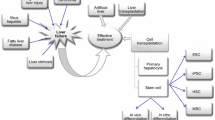Abstract
Background
Human chemically induced liver progenitors (hCLiP) induced by small molecules produced by mature hepatocytes can potentially overcome issues related to hepatocyte transplantation, such as graft rejection or donor shortage. However, to our knowledge, no studies have explored the induction of hCLiP from mature hepatocytes (MHs) in damaged liver, indicated for liver transplantation.
Methods
Liver tissues were collected from surgically resected livers, including damaged livers, of 86 patients at our department, and hepatocytes were isolated using the collagenase perfusion method. Hepatocytes isolated from 33 of these 86 donors were cultured in YAC medium containing Y-27632 (ROCK inhibitor), A-83-01 (TGF-β type I receptor inhibitor), and CHIR99021 (GSK-3 inhibitor) to induce hCLiP, and their functions were assessed.
Results
Hepatocytes were isolated regardless of the liver fibrosis classifications (viability: F0,1: 87.2 ± 13.2%; F2,3: 87.8 ± 13.1%; and F4: 86.3 ± 4.2%). Most hepatocytes cultured in the YAC medium acquired the liver progenitor cell (LPC) gene. The expression of MH markers (ALB, HNF4α, G6PC, and CYP1A2) was lower in hCLiP than in MHs before reprogramming. Reverse transcription-polymerase chain reaction revealed that hCLiP markers (e.g., EpCAM, SOX9, CK19, and CD133) exhibited higher expression in LPCs than in MHs. Furthermore, hCLiPs had the ability to differentiate into hepatocytes, and were engrafted on the liver surface as mature hepatocytes.
Conclusion
Hepatocytes could be isolated from damaged liver. Furthermore, hCLiP may be obtained from hepatocytes isolated from damaged liver and may differentiate into MHs in vitro. Autologous hCLiP can potentially be transplanted without tumorigenesis and remodel damaged liver.






Similar content being viewed by others
References
Anderson TN, Zarrinpar A. Hepatocyte transplantation: past efforts, current technology, and future expansion of therapeutic potential. J Surg Res. 2018;226:48–55.
Pareja E, Gomez-Lechon MJ, Cortes M, et al. Human hepatocyte transplantation in patients with hepatic failure awaiting a graft. Eur Surg Res. 2013;50:273–81.
Liu H, Kim Y, Sharkis S, et al. In vivo liver regeneration potential of human induced pluripotent stem cells from diverse origins. Sci Transl Med. 2011;3:82ra39.
Carpentier A, Tesfaye A, Chu V, et al. Engrafted human stem cell-derived hepatocytes establish an infectious HCV murine model. J Clin Invest. 2014;124:4953–64.
Sekiya S, Suzuki A. Direct conversion of mouse fibroblasts to hepatocyte-like cells by defined factors. Nature. 2011;475:390–3.
Omer L, Hudson EA, Zheng S, et al. CRISPR correction of a homozygous low-density lipoprotein receptor mutation in familial hypercholesterolemia induced pluripotent stem cells. Hepatol Commun. 2017;1:886–98.
Forbes SJ, Gupta S, Dhawan A. Cell therapy for liver disease: from liver transplantation to cell factory. J Hepatol. 2015;62:S157–69.
Katsuda T, Kawamata M, Hagiwara K, et al. Conversion of terminally committed hepatocytes to culturable bipotent progenitor cells with regenerative capacity. Cell Stem Cell. 2017;20:41–55.
Zhang K, Zhang L, Liu W, et al. In vitro expansion of primary human hepatocytes with efficient liver repopulation capacity. Cell Stem Cell. 2018;23:806-19 e4.
Du C, Feng Y, Qiu D, et al. Highly efficient and expedited hepatic differentiation from human pluripotent stem cells by pure small-molecule cocktails. Stem Cell Res Ther. 2018;9:58.
Fu GB, Huang WJ, Zeng M, et al. Expansion and differentiation of human hepatocyte-derived liver progenitor-like cells and their use for the study of hepatotropic pathogens. Cell Res. 2019;29:8–22.
Katsuda T, Matsuzaki J, Yamaguchi T, et al. Generation of human hepatic progenitor cells with regenerative and metabolic capacities from primary hepatocytes. Elife. 2019;8:47313.
Sakai Y, Koike M, Kawahara D, et al. Controlled cell morphology and liver-specific function of engineered primary hepatocytes by fibroblast layer cell densities. J Biosci Bioeng. 2018;126:249–57.
Bedossa P, Poynard T. An algorithm for the grading of activity in chronic hepatitis C. The METAVIR cooperative study group. Hepatology. 1996;24:289–93.
Miyamoto D, Sakai S, Huang Y, et al. Functional changes of cocultured hepatocyte sheets subjected to continuous liver regeneration stimulation in cDNA-uPA/SCID mouse: differences in transplantation sites. Regen Ther. 2021;18:7–11.
Bhogal RH, Hodson J, Bartlett DC, et al. Isolation of primary human hepatocytes from normal and diseased liver tissue: a one hundred liver experience. PLoS ONE. 2011;6:e18222.
Zhang CY, Yuan WG, He P, et al. Liver fibrosis and hepatic stellate cells: etiology, pathological hallmarks and therapeutic targets. World J Gastroenterol. 2016;22:10512–22.
Kim Y, Kang K, Lee SB, et al. Small molecule-mediated reprogramming of human hepatocytes into bipotent progenitor cells. J Hepatol. 2019;70:97–107.
Tarlow BD, Pelz C, Naugler WE, et al. Bipotential adult liver progenitors are derived from chronically injured mature hepatocytes. Cell Stem Cell. 2014;15:605–11.
Huang Y, Miyamoto D, Li PL, et al. Chemical conversion of aged hepatocytes into bipotent liver progenitor cells. Hepatol Res. 2021;51:323–35.
Huppert SS, Campbell KM. Emerging advancements in liver regeneration and organogenesis as tools for liver replacement. Curr Opin Organ Transplant. 2016;21:581–7.
Allen KJ, Mifsud NA, Williamson R, et al. Cell-mediated rejection results in allograft loss after liver cell transplantation. Liver Transpl. 2008;14:688–94.
Oldhafer F, Bock M, Falk CS, et al. Immunological aspects of liver cell transplantation. World J Transplant. 2016;6:42–53.
Huang Y, Sakai Y, Hara T, et al. Differentiation of chemically induced liver progenitor cells to cholangiocytes: investigation of the optimal conditions. J Biosci Bioeng. 2020;130:545–52.
Funding
This work was supported by the Japan Agency for Medical Research and Development (grant number: 20bm0404042h0002), Japan.
Author information
Authors and Affiliations
Corresponding author
Ethics declarations
Conflict of interest
The authors declare that they have no competing interests.
Additional information
Publisher's Note
Springer Nature remains neutral with regard to jurisdictional claims in published maps and institutional affiliations.
Supplementary Information
Below is the link to the electronic supplementary material.
535_2022_1869_MOESM1_ESM.tif
Supplementary file1 Fig. S1 Gene properties for induction human CLiPs. RT-qPCR analysis of hCLiPs and mature hepatic cell genes. Values were determined relative to GAPDH and presented as fold-change relative to the hCLiPs. t test: *< 0.05, **p < 0.01, (n = 5). (TIF 62 KB)
Rights and permissions
About this article
Cite this article
Miyoshi, T., Hidaka, M., Miyamoto, D. et al. Successful induction of human chemically induced liver progenitors with small molecules from damaged liver. J Gastroenterol 57, 441–452 (2022). https://doi.org/10.1007/s00535-022-01869-5
Received:
Accepted:
Published:
Issue Date:
DOI: https://doi.org/10.1007/s00535-022-01869-5




